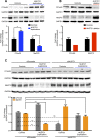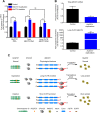NUDT21-spanning CNVs lead to neuropsychiatric disease and altered MeCP2 abundance via alternative polyadenylation
- PMID: 26312503
- PMCID: PMC4586391
- DOI: 10.7554/eLife.10782
NUDT21-spanning CNVs lead to neuropsychiatric disease and altered MeCP2 abundance via alternative polyadenylation
Abstract
The brain is sensitive to the dose of MeCP2 such that small fluctuations in protein quantity lead to neuropsychiatric disease. Despite the importance of MeCP2 levels to brain function, little is known about its regulation. In this study, we report eleven individuals with neuropsychiatric disease and copy-number variations spanning NUDT21, which encodes a subunit of pre-mRNA cleavage factor Im. Investigations of MECP2 mRNA and protein abundance in patient-derived lymphoblastoid cells from one NUDT21 deletion and three duplication cases show that NUDT21 regulates MeCP2 protein quantity. Elevated NUDT21 increases usage of the distal polyadenylation site in the MECP2 3' UTR, resulting in an enrichment of inefficiently translated long mRNA isoforms. Furthermore, normalization of NUDT21 via siRNA-mediated knockdown in duplication patient lymphoblasts restores MeCP2 to normal levels. Ultimately, we identify NUDT21 as a novel candidate for intellectual disability and neuropsychiatric disease, and elucidate a mechanism of pathogenesis by MeCP2 dysregulation via altered alternative polyadenylation.
Keywords: MeCP2; NUDT21; alternative polyadenylation; human; intellectual disability; neuropsychiatric disease; neuroscience.
Conflict of interest statement
HYZ: Senior editor,
The other authors declare that no competing interests exist.
Figures







Similar articles
-
NUDT21 negatively regulates PSMB2 and CXXC5 by alternative polyadenylation and contributes to hepatocellular carcinoma suppression.Oncogene. 2018 Aug;37(35):4887-4900. doi: 10.1038/s41388-018-0280-6. Epub 2018 May 21. Oncogene. 2018. PMID: 29780166
-
Partial loss of CFIm25 causes learning deficits and aberrant neuronal alternative polyadenylation.Elife. 2020 Apr 22;9:e50895. doi: 10.7554/eLife.50895. Elife. 2020. PMID: 32319885 Free PMC article.
-
The role of NUDT21 in microRNA-binging sites of EZH2 gene increases the of risk preeclampsia.J Cell Mol Med. 2019 May;23(5):3202-3213. doi: 10.1111/jcmm.14179. Epub 2019 Mar 18. J Cell Mol Med. 2019. PMID: 30883033 Free PMC article.
-
Relationship between NUDT21 mediated alternative polyadenylation process and tumor.Front Oncol. 2023 Feb 2;13:1052012. doi: 10.3389/fonc.2023.1052012. eCollection 2023. Front Oncol. 2023. PMID: 36816917 Free PMC article. Review.
-
The emerging roles of CFIm25 (NUDT21/CPSF5) in human biology and disease.Wiley Interdiscip Rev RNA. 2023 May-Jun;14(3):e1757. doi: 10.1002/wrna.1757. Epub 2022 Aug 14. Wiley Interdiscip Rev RNA. 2023. PMID: 35965101 Free PMC article. Review.
Cited by
-
Identification and characterization of conserved noncoding cis-regulatory elements that impact Mecp2 expression and neurological functions.Genes Dev. 2021 Apr 1;35(7-8):489-494. doi: 10.1101/gad.345397.120. Epub 2021 Mar 18. Genes Dev. 2021. PMID: 33737384 Free PMC article.
-
RNA Modifications and RNA Metabolism in Neurological Disease Pathogenesis.Int J Mol Sci. 2021 Nov 1;22(21):11870. doi: 10.3390/ijms222111870. Int J Mol Sci. 2021. PMID: 34769301 Free PMC article. Review.
-
NUDT21 negatively regulates PSMB2 and CXXC5 by alternative polyadenylation and contributes to hepatocellular carcinoma suppression.Oncogene. 2018 Aug;37(35):4887-4900. doi: 10.1038/s41388-018-0280-6. Epub 2018 May 21. Oncogene. 2018. PMID: 29780166
-
Cleavage and polyadenylation: Ending the message expands gene regulation.RNA Biol. 2017 Jul 3;14(7):865-890. doi: 10.1080/15476286.2017.1306171. Epub 2017 Apr 28. RNA Biol. 2017. PMID: 28453393 Free PMC article.
-
Molecular Mechanisms for CFIm-Mediated Regulation of mRNA Alternative Polyadenylation.Mol Cell. 2018 Jan 4;69(1):62-74.e4. doi: 10.1016/j.molcel.2017.11.031. Epub 2017 Dec 21. Mol Cell. 2018. PMID: 29276085 Free PMC article.
References
-
- Balmer D, Goldstine J, Rao YM, LaSalle JM. Elevated methyl-CpG-binding protein 2 expression is acquired during postnatal human brain development and is correlated with alternative polyadenylation. Journal of Molecular Medicine. 2003;81:61–68. - PubMed
Publication types
MeSH terms
Substances
Grants and funding
LinkOut - more resources
Full Text Sources
Medical

